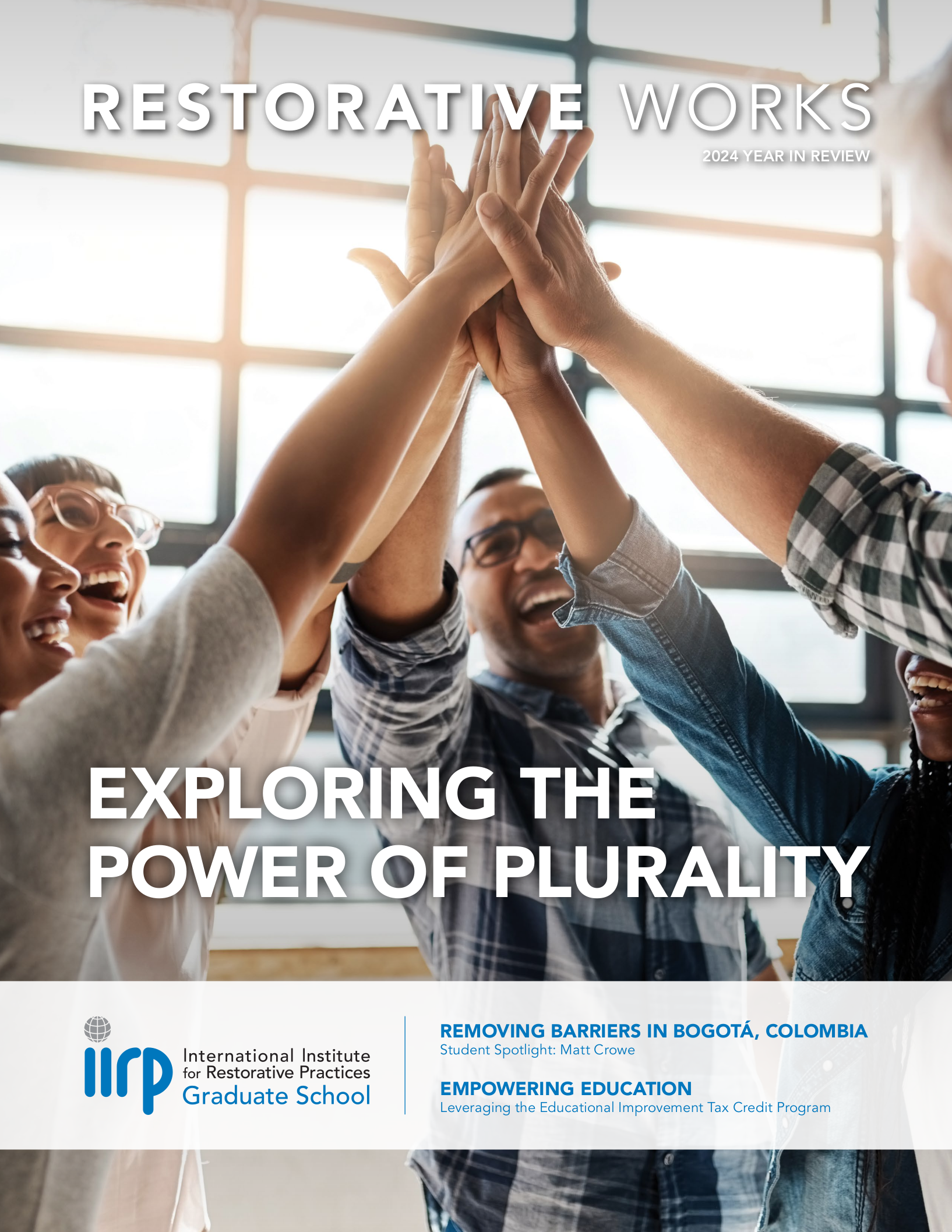News & Announcements
- Details
- Written by Joshua Wachtel
Here's another great short video from Restorative Justice Colorado. This one looks at a youth crime from a victim's point of view.
- Details
- Written by Joshua Wachtel
Here's piece #3 in this continuing series on some of the great workshops I attended at IIRP's 15th World Conference. (I would note that some of the power points from various sessions have been posted on the IIRP web site - click here.)
 Chuck Saufler, who is based in Maine, was a guidance counselor and now trains and consults with schools and communities. His focus, according to his Safe Schools for All web site, has been "to reduce bullying and peer aggression in children and adolescents through the implementation of restorative practices." His session at the conference, “Connecting Restorative School Practices to Brain Research and Bullying Prevention,” struck me as significant for establishing a scientific foundation for certain aspects of restorative practices.
Chuck Saufler, who is based in Maine, was a guidance counselor and now trains and consults with schools and communities. His focus, according to his Safe Schools for All web site, has been "to reduce bullying and peer aggression in children and adolescents through the implementation of restorative practices." His session at the conference, “Connecting Restorative School Practices to Brain Research and Bullying Prevention,” struck me as significant for establishing a scientific foundation for certain aspects of restorative practices.
After introducing himself, Chuck showed a YouTube video demonstrating the “Still-face Experiment” (see video below). In this experiment, a mother of a child first demonstrates her child’s full engagement when she talks to her, smiles, and responds with positive affective facial expressions. Then the mother turns on a dime and presents a nonreactive face to her child. The child tries every trick to get the mother to engage but then breaks down and cries. This set the keynote for Chuck’s talk – how from a very young age we respond best when those we rely upon engage and connect with us.
- Details
- Written by Joshua Wachtel
At the beginning of the summer Ted Wachtel described Nils Christie's plenary at the European Forum for Restorative Justice in Helsinki, Finland. Christie "talked about the shootings of children that occurred last summer on an island in Norway at a labor party camp and the bombing in Oslo. And he talked about how Norway seems to have become increasingly restorative. The response of the public, instead of for vengeance was one of acknowledgement of harm, of caring for the people whose children were victims and for those who managed to survive."
- Details
- Written by Joshua Wachtel
 Teacher Robert Roth at a picnic celebrating the high school's gain in test scores. Photo by Winni Wintermeyer at Mother Jones[At last summer's IIRP Summer Symposium: Turning the Tide (August 2011), I heard a lot about the problems of No Child Left Behind and how schools might be creating positive environments and making tangible changes but still be deemed failing by the standards of current law which relies upon the results of standardized testing alone.
Teacher Robert Roth at a picnic celebrating the high school's gain in test scores. Photo by Winni Wintermeyer at Mother Jones[At last summer's IIRP Summer Symposium: Turning the Tide (August 2011), I heard a lot about the problems of No Child Left Behind and how schools might be creating positive environments and making tangible changes but still be deemed failing by the standards of current law which relies upon the results of standardized testing alone.
Here's a lengthy piece from Mother Jones about one school in San Francisco that seems to fit into this category. It has a high population of Latino students, who don't necessarily fare well on standardized tests. And yet the school clearly has a caring principal and enthusiastic teachers. Maria, the main student profiled in the piece, flourishes there.
Nowhere in the article is the phrase restorative practices mentioned, but clearly the people in the school have done something to foster a warm atmosphere with positive relationships. This quote stuck out at me:
"I have seen about 20 rounds of classroom reform in my teaching career," Roth [a teacher in the school] told me recently. "You know what I haven't seen? Serious dialogue with teachers, students, and parents. They can identify successful teaching, but they are rarely a part of the discussion."
Those kinds of discussions and inclusiveness of all the stakeholders fit neatly in the basic restorative premise of doing things "with" people, rather "to" them or "for" them.
The full 4-page piece can be found here: "Everything You've Heard About Failing Schools Is Wrong" by Kristina Rizga.
- Details
- Written by Joshua Wachtel
With so many states, cities and school districts reevaluating discipline codes, Dignity in Schools, a U.S.-wide coalition of youth, parents, educators, grassroots and advocacy groups, which aims to end the school "pushout" crisis and foster positive approaches to school climate and discipline, has published a "Model Code on Education and Dignity." At the same Dignity in Schools is joined by 50 other groups calling for a national moratorium on the use of out-of-school suspensions for students.
- Details
- Written by Joshua Wachtel
I found this very impressive video on YouTube the other day through the Restorative Justice Colorado web site. Officer Greg Ruprecht of the Longmont Police speaks very movingly about the power and potential of restorative justice. He tells the story of the first conference he ran and then discusses how RJ works to prevent repeat offending by teaching people the impact of their actions and giving them an opportunity to take responsibility for their deeds.
Enjoy when you've got 8 minutes to spend!
- Details
- Written by Joshua Wachtel
 Photo by Phillip Capper - Flickr Creative CommonsHere's bit of good news by Anne-Marie Emerson from the Wanganui Chronicle. Inspired by the city of Hull, UK, this small city in New Zealand moves toward becoming "restorative" itself. Wanganui is hosting a conference on the subject on September 10 and 11 entitled "Whanganui: Towards a Restorative City." Estelle Macdonald of Hull Centre for Restorative Practice, an IIRP international affiliate, presents the keynote. Paul Nixon, a pioneer in family group conferencing, and Marg Thorsborne, who ran the first ever school-based conference in 1994, will also speak.
Photo by Phillip Capper - Flickr Creative CommonsHere's bit of good news by Anne-Marie Emerson from the Wanganui Chronicle. Inspired by the city of Hull, UK, this small city in New Zealand moves toward becoming "restorative" itself. Wanganui is hosting a conference on the subject on September 10 and 11 entitled "Whanganui: Towards a Restorative City." Estelle Macdonald of Hull Centre for Restorative Practice, an IIRP international affiliate, presents the keynote. Paul Nixon, a pioneer in family group conferencing, and Marg Thorsborne, who ran the first ever school-based conference in 1994, will also speak.
According to the story, David Alexander, one of the conferences organizers:
...said the aim of the conference was to help Wanganui people learn more about being a restorative city.
- Details
- Written by Joshua Wachtel
 Lady Justice from Flick Creative CommonsIn this recent post from the West Berkshire (UK) Council, officials report a nearly 50% reduction in the number of youth entering the youth justice system year over year. The article reads:
Lady Justice from Flick Creative CommonsIn this recent post from the West Berkshire (UK) Council, officials report a nearly 50% reduction in the number of youth entering the youth justice system year over year. The article reads:
A fall of 48.7% is shown between January and December 2011 (compared with same period for 2010). The decline for the rest of England averages 19.3%. The team is a multi-agency partnership between Thames Valley Police, National Probation service, the Berkshire Health Care Foundation Trust and West Berkshire Council.
The Team attributes two major factors to this impressive figure. Firstly, in 2001 the partnership established an Early Intervention Team to work with young people between the ages of 8 and 15 years focussing on preventing them offending in the first place, or to intervene at an early stage to halt further offending. This supported other services developed across the West Berkshire area to support vulnerable children, which have made them less likely to offend.
- Details
- Written by Joshua Wachtel
Here is the second in a series of pieces about IIRP’s 15th International Conference, Building a Worldwide Learning Network, that took place August 1-3, 2012. I’ll be writing about some of the great sessions I attended, beginning with one titled “Restore with a Smile: The Provocative Approach” presented by Jan and Laurien Ruigrok from the Netherlands.

As you might be able to tell from the title of this workshop, Jan’s approach was unconventional. When I arrived at the session, everyone was seated in rows of chairs, but once it began the chairs went to the side and the room was turned into a play space. Jan said that Rule #1 of the provocative approach is: “Get yourself into the laughing state.” So when someone came in the room a little bit late, Jan asked us all to jump in the air with our hands held high in imitation of the well-known Masai jumping greeting. We were laughing by that point.
Jan also showed us his version of the social discipline window, which he’d modified slightly (see figure). He put it in terms of status and self-esteem. If both “I” and “you” believe ourselves low in status, that puts us in a “depressed relationship.” If “I” put myself above “you” then it’s an aggressive relationship. If “I” put myself below “you” that puts me in a state of despair. But if both of us have a positive view of ourselves, that puts us in the position of growth. That’s the box we normally call the “with” or restorative box.

- Details
- Written by Joshua Wachtel
An addendum to Friday's post "Followup: Philadelphia revises conduct code."
From the Notebook's "SRC adopts revised student code of conduct by Dale Mezzacappa, which places more emphasis on the adoption of restorative practices by the Philadelphia School District:
Students and organizers from the Campaign for Nonviolent Schools said that they felt the new code was a good first step but said it could still be improved – especially by putting more emphasis on “restorative practices” rather than punishment.

Restorative Works Year in Review 2024 (PDF)
All our donors are acknowledged annually in Restorative Works.
